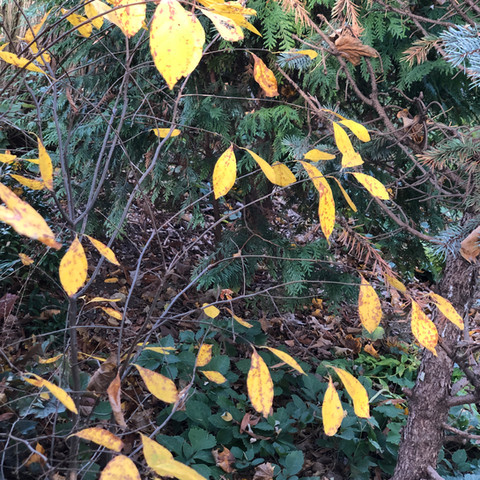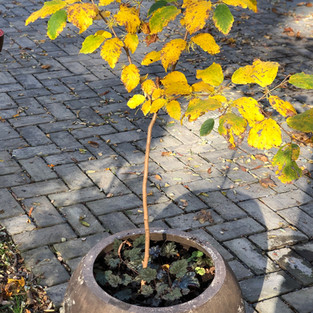Chesapeake Native Plants: Falling for Yellow
- Nov 11, 2020
- 3 min read
Updated: Jan 10, 2021
Adding sunshine on a rainy day.

Yellow colors are prevalent in Chesapeake native perennials and shrubs from spring bloomers like celandine poppy (Stylophorum diphyllum), golden Alexander (Zizia aurea) and spicebush to a passel of summer blooming flowers to the amsonia and goldenrods (solidago) of fall. If you like consistent color in your garden design, yellow is easy to have with natives.
I recently realized a sunny accident in our 1/8 acre urban garden -- the dotting of yellow fall color that looks almost purposeful. I had not given much thought to planning fall color. Instead, I was focused on having as much color and as many berries for birds as possible. Yet, there they are: yellow punctuation points. It occurred to me, and it probably already has for you, this is a great time to look at your garden to see whether there is a fall color you covet and where it might go. If it's yellow, here are some easy to grow plants.
Amsonia (sun, part shade)

Amsonia (Amsonia hubrichtii), a sun loving 4 foot high perennial puts on an ombre show of color in fall but the end result is a yellow gold that holds for quite a while. Planted in mass, they reliably provide great fall yellows. Amsonia also grows just fine in part shade but the more sun, the brighter the fall color. Read more about amsonia here.
Spicebush (shade)
Spicebush (Lindera benzoin) blooms with chartreuse yellow flowers in spring and foliage turns yellow in fall. While many sources say this is a sun, part shade plant, here in the Chesapeake it commonly grows naturally as an understory shrub or tree. We have one in full shade and it blooms and turns yellow in fall. Read more about spicebush here. This shrub feeds caterpillars of the beautiful spicebush swallowtail butterflies.

(Photo from Shutterstock)
Sumac 'grow low' (sun, part shade)

Sumac (Rhus aromatic "Gro-Low") is a small shrub. It grows to 2 feet tall and up to 8 feet wide In full sun, this is a fairly fast growing shrub meaning it will spread. It often is recommended for naturalizing in difficult spots like steep banks. This one, in a part sun location, has kept its low height for several years and has not spread.
Summerwsweet (sun, part shade)

Summersweet (Clethra alnifolia) is a sun to part shade shrub available in dwarf (growing to 4 feet) as well as regular size (growing to 8 feet). In addition to the profusion of pink or white fragrant summer blooms, the shrub turns yellow gold in fall. It grows best in moister soils but will grow well in average soils once established. More about summersweet here.
Witch Hazel (sun, part shade)
Witch hazel (Hamamelis virginiana) is a fascinating plant that flowers in November and December. The foliage often turns yellow in fall. This can be grown as a shrub with multiple branches or as a tree by pruning out the shorter stems at the base as it grows. Ultimately, a shrub or tree can grow 15 to 20 feet tall but that is over a very long time and if you desire something smaller, it can easily be pruned. It also does just fine in containers as is the case with the very young one above. There are many hybrids of the native that are commonly available. Typically, the hybrids bloom in mid-winter and bloom colors range from oranges to reds.. You will know if you have the native witch hazel by the pale yellow color and time of bloom.
Of course, I have to remind myself, fall colors, like plants, are variable. The same plant turns different shades of red, orange or yellow depending on the year's rainfall and other weather conditions. Also, as plants grow and die, available sunlight changes from year to year creating variations in color.
That's just the nature of gardening!

























Comments